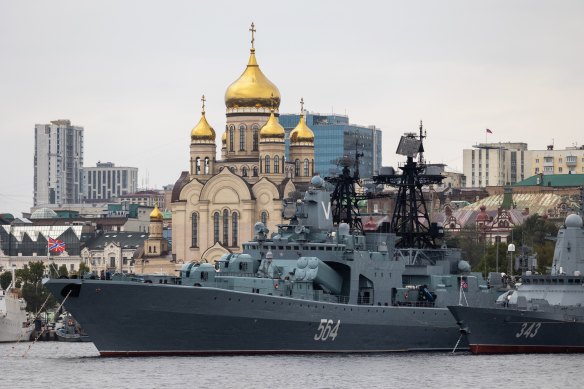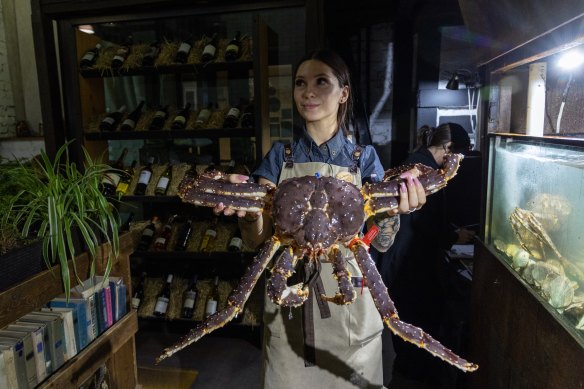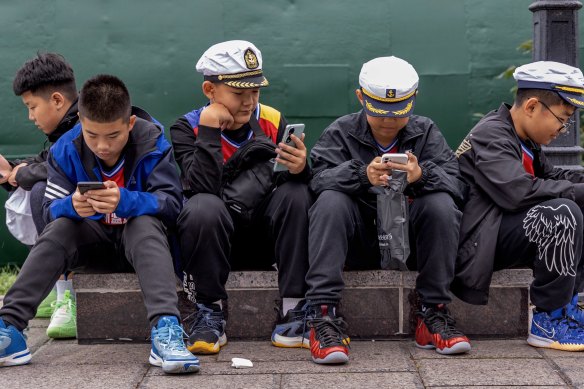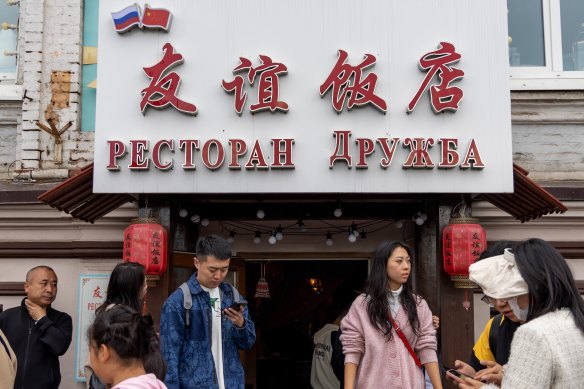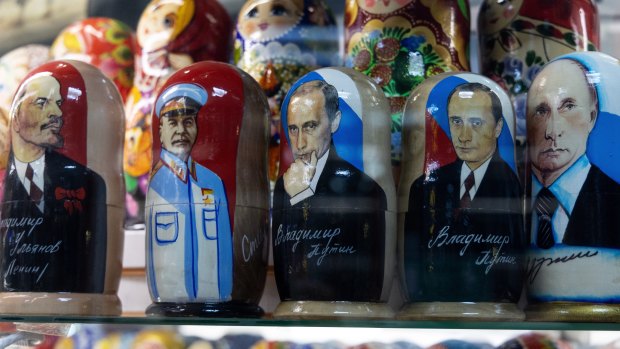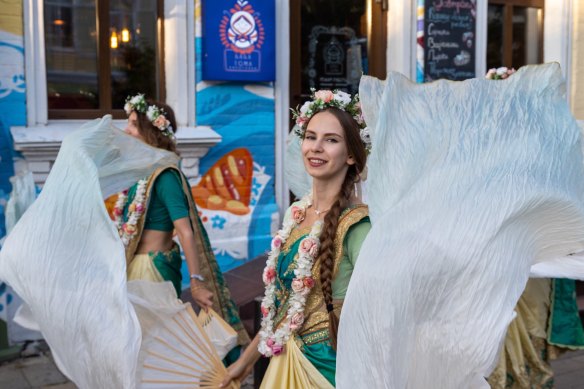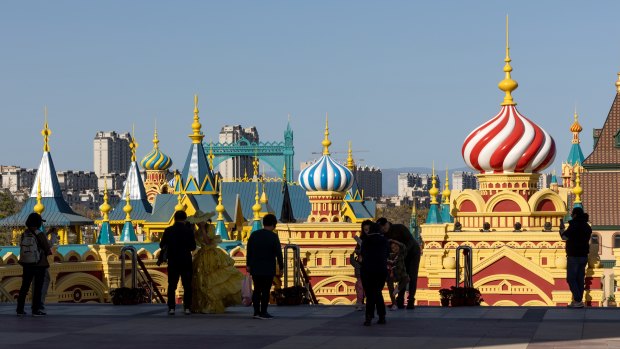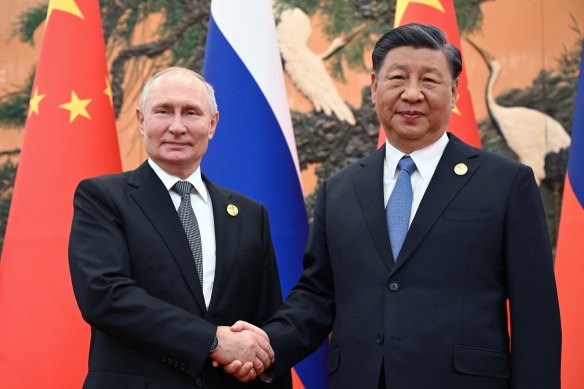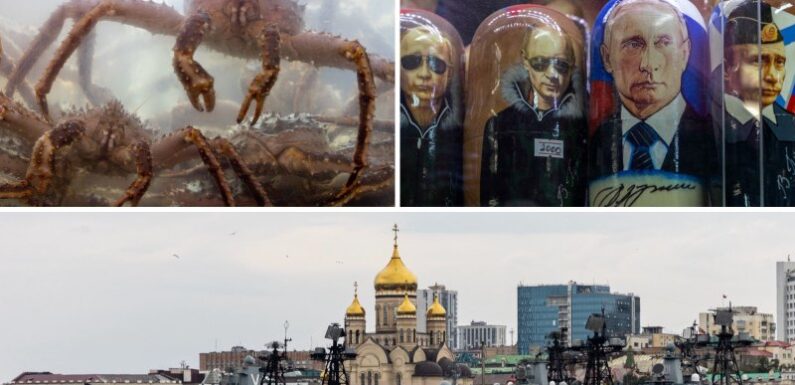
Save articles for later
Add articles to your saved list and come back to them any time.
Vladivostok has always been on the edge of empires. Sandwiched between China, Russia and North Korea, the city is now dominated by Orthodox churches and Moscow’s Pacific Fleet.
China’s Yuan, Ming and Qing dynasties ruled here until the 1860s. Chinese maps still call it Haishenwai. It took decades of bitter negotiations for the territorial dispute to be resolved and only years for it to be largely forgotten.
Russia’s Pacific Fleet in Vladivostok. Credit: Sanghee Liu
Now, the city known as “Lord of the East” is at the centre of a blossoming relationship between Russia and China that has overcome decades of mistrust because of a common enemy: the West.
“In the past, we believed too much in the West,” Wang Wen, executive director of the Chongyang Institute for Financial Studies told the Eastern Economic Forum in Vladivostok, Russia, in September.
“Now, we have awakened. More and more countries believe that being too dependent on the West is dangerous.”
In Beijing on Wednesday, China’s President Xi Jinping and Russian President Vladimir Putin – who have respectively threatened and waged war against smaller neighbours – led hundreds of delegates at the Belt and Road Forum in condemning Western governments for imposing sanctions, driving ideological confrontation and accused global financial institutions of abandoning debt-laden economies.
It was the latest stanza in a years-long push by Xi and Putin to remake the rules-based order, the global framework that has governed international relations through institutions such as the United Nations since the end of World War II.
“You have just said ‘rules-based order’,” Putin said in response to a question from a Chinese journalist on Tuesday. “Have you ever seen those rules? No, you haven’t because no one has agreed on them with anyone.”
Sanctions from Europe and the United States for its war on Ukraine have hammered the Russian economy and driven it closer to China than ever. At the same time, Chinese officials have been sanctioned for their roles in human rights abuses in Xinjiang and Hong Kong.
Chinese technology firms have also been cut off from access to sensitive and transformational technology such as semiconductors.
During the 2022 Winter Olympics in Beijing, Putin and Xi heaped praise on the “unbreakable bond” and “no-limits partnership” that had developed between their two countries. That high-level diplomatic partnership is now filtering right through the Russian economy.
The only new foreign cars being sold in Russia are Chinese, much of the energy powering China is Russian (some $140 billion worth last year) and in the port city of Vladivostok, all the famous local king crabs are being exported to diners west of the border.
“In the past, some crabs were exported to South Korea but not any more because of sanctions,” said a king crab shop owner in Hunchun on the Chinese border. “Last week I sold almost 100 crabs in one day. It was the best time in the 14-year history of my shop.”
Total trade between Russia and China jumped more than 50 per cent in the first half of this year, according to figures from the Chinese customs authority.
A waitress displays a king crab to Chinese customers in Vladivostok. Credit: Sanghee Liu
There has been a consolidation of the China-Russia alignment over the past decade, according to University of NSW international relations expert Dr Alexander Korolev.
“The very powerful driving force is the simultaneous deterioration of US-China and US-Russia relations,” he said.
In Vladivostok, Victor, a 29-year-old economist, who like many people in Russia asks only to be identified by his first name because talking to the media can be politically sensitive, said a tighter partnership between the two neighbours was inevitable.
“We have resources, China has the money,” he said.
Young Chinese tourists in Russian sailors caps next to the S-56, a replica of Stalinets-class submarine of the Soviet Navya in Vladivostok.Credit: Sanghee Liu
Victor said Chinese technology brands Xiaomi, Huawei and Honor – all known for manufacturing smartphones – are flooding into the local market as US, European and Japanese companies pull out.
By the end of this year, only 14 car brands will remain in Russia after the European Union and the US banned vehicle exports to the country in 2022. Three are domestic and 11 are Chinese, according to the Russian Automobile Dealers Association.
From January to August 2023, China exported 544,000 cars to Russia – a year-on-year increase of more than 600 per cent.
Alexander, a Vladivostok sales manager at a car dealership for Chinese car brand Chery, said Russian sales for the company have surged over the past year.
A shop sign in Chinese and Russian in Vladivostok.Credit: Sanghee Liu
“Because there is no other option,” he said.
One of his customers, a 27-year-old financial adviser at local company VTB Leasing named Sergey, said he had no choice but to buy Chinese vehicles despite his preference for Japanese cars.
“It’s still not clear if their fatal flaws and weaknesses have not been exposed yet,” he said.
But Sergey was happy to be buying from a country that has not imposed sanctions on the Russian economy. “Of course, we are brothers,” he said.
Putin-themed Russian matryoshka dolls along with Vladimir Lenin and Joseph Stalin in Vladivostok.Credit: Sanghee Liu
For Russians, who until the 1990s were used to being the dominant power in the region, the newfound dependence on China is the culmination of a sharp economic fall from the heights of the Soviet Union.
“Over a very short period of time, Russia deteriorated significantly. It went through economic degradation, and it was Russia’s own fault. Now it is completely dependent on the export of energy resources,” said Korolev, the international relations expert.
“China became a manufacturing superpower. Russia, which was once ahead on many parameters, is no longer a giant.”
In Vladivostok, Chinese tour guide Tian Xiaohong points out that the Russian emblem is a double-headed eagle watching east and west respectively. Chinese tourists here remain sceptical of Russia’s insatiable territorial ambition.
Folk artists perform on the street in Vladivostok. Credit: Sanghee Liu
But Victor has no illusions about the demise of a once great power and the rise of its superpower neighbour.
“I don’t think Russia is one of the powers,” he said. “It’s a little country. Only 150 million people, 10 times less than in China.”
Korolev said if you compare numbers such as population and GDP between China and Russia it is “a very uneven relationship”.
“China is obviously getting ahead on multiple indicators of comprehensive power,” he said.
A Russian-themed amusement park in Hunchun, China.Credit: Sanghee Liu
“But that is only part of the story. Russia is China’s only great power ally, so to speak. If China-US relations deteriorate further, these geopolitical factors become much more important than just simple GDP figures.”
The two nations’ most pressing common interest may lie more than 5000 kilometres away from Vladivostok, in a passage of water between Malaysia, Indonesia and Singapore.
“China’s biggest headache, in terms of energy supplies, is the Malacca Strait, which is a choke point that can be shut down by the US Navy very quickly,” said Korolev.
“So that is why China is investing billions and billions of dollars in the on-land energy infrastructure with Russia.”
Putin and Xi at the Belt and Road Forum in Beijing.Credit: AP
Russia’s Power of Siberia pipeline began supplying gas directly to China in late 2019 through a 30-year contract worth more than $600 billion. Putin advanced negotiations on a second Power of Siberia 2 pipeline from Russia to Mongolia to China on the sidelines of the Belt and Road Forum in Beijing this week.
“We help and support each other in certain areas so that we can live more conveniently,” said Oksana, the chef at the Solnechny Culture Centre Hotel in Vladivostok. “It’s good to be friends.”
Get a note directly from our foreign correspondents on what’s making headlines around the world. Sign up for the weekly What in the World newsletter here.
Most Viewed in World
From our partners
Source: Read Full Article
